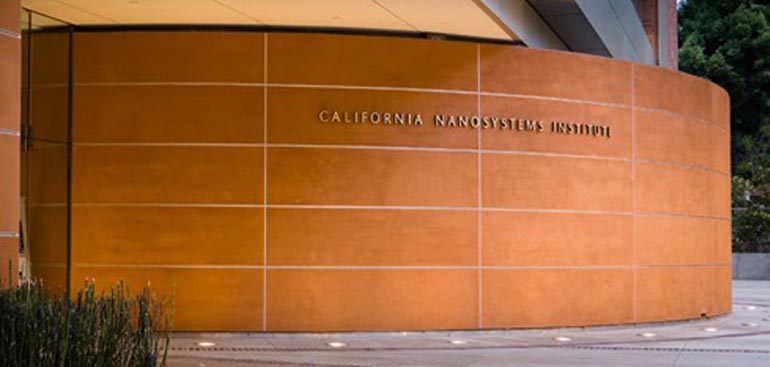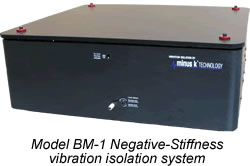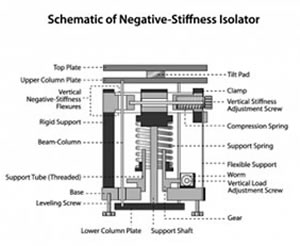|
Minus K Technology Helps Alternating
Current Scanning Tunneling Microscopes (ACSTM ) Illuminate Unprecedented
Details of Single Molecule Chemical Behavior

Developed in the early 1990s by Prof Paul Weiss, the
nano-pioneering Director of the Weiss Group, a nanotechnology research unit at
UCLA's California NanoSystems Institute, the ACSTM's single-molecule
measurement techniques have illuminated unprecedented details in chemical
behavior, including observations of the motion of a single molecule and even
the vibration of a single bond within a molecule.
"The ACSTM enables
interactions within and between molecules to be designed, directed, measured,
understood, and exploited," said David McMillan, lead technician at the Weiss
Group. "The group examines how these interactions influence chemistry,
dynamics, structure, electronic function, and other properties. "
The
Challenge:
 To achieve these nano-level chemical and
spectroscopic data sets requires that the ACSTM be positioned in an
ultra-stable operating environment, one free of low-frequency vibrations. "The
lab was using almost exclusively optical tables on pneumatic isolation," said
McMillan. "One of our big problems has been space constraint. We needed smaller
pneumatic optical tables to fit, but as the air tables get smaller, their
vibration isolation performance diminishes." To achieve these nano-level chemical and
spectroscopic data sets requires that the ACSTM be positioned in an
ultra-stable operating environment, one free of low-frequency vibrations. "The
lab was using almost exclusively optical tables on pneumatic isolation," said
McMillan. "One of our big problems has been space constraint. We needed smaller
pneumatic optical tables to fit, but as the air tables get smaller, their
vibration isolation performance diminishes."
"Space was not the only
issue," continued McMillan. "Our lab was occasionally moved to different
locations at UCLA. In 2009, we were located on the sixth floor of a
steel-structure building that had significant movement creating low-frequency
vibrations. Under these conditions, the pneumatic tables were highly
perturbable, and difficult to get vibration isolation and thermal stability. We
were not able to functionally run our microscopes using the air tables. So, we
began looking for another vibration isolation solution."
The
Solution:
 The team looked at both an active vibration isolation
unit as well as a Minus K Negative-Stiffness system. "We compared the two
systems," explained McMillan "and the Negative Stiffness system performed
better with the frequencies of our concern, which were the lower frequencies
caused by the movements of the building - between 10 and 24 hertz. Compared to
the optical tables, the Minus K Negative-Stiffness isolator performed
significantly better. Where before, we could not even use our microscopes with
the air tables, when we put in the Negative-Stiffness isolator we had full
vibration and thermal functionality." "Over the past four years we have put six
Negative-Stiffness isolation systems into the lab," McMillan concluded, "and
since then, we have relocated into quarters with less movement. Although we
still have some air tables in use, our staff and graduate students prefer the
Negative-Stiffness isolators." The team looked at both an active vibration isolation
unit as well as a Minus K Negative-Stiffness system. "We compared the two
systems," explained McMillan "and the Negative Stiffness system performed
better with the frequencies of our concern, which were the lower frequencies
caused by the movements of the building - between 10 and 24 hertz. Compared to
the optical tables, the Minus K Negative-Stiffness isolator performed
significantly better. Where before, we could not even use our microscopes with
the air tables, when we put in the Negative-Stiffness isolator we had full
vibration and thermal functionality." "Over the past four years we have put six
Negative-Stiffness isolation systems into the lab," McMillan concluded, "and
since then, we have relocated into quarters with less movement. Although we
still have some air tables in use, our staff and graduate students prefer the
Negative-Stiffness isolators."
Full article here:
https://minusk.com/content/in-the-news/R&D_0616.html?newsletter-lp
For
more Information on Minus K products and our negative stiffness technology
contact at request@minuk.com or
here. |

 To achieve these nano-level chemical and
spectroscopic data sets requires that the ACSTM be positioned in an
ultra-stable operating environment, one free of low-frequency vibrations. "The
lab was using almost exclusively optical tables on pneumatic isolation," said
McMillan. "One of our big problems has been space constraint. We needed smaller
pneumatic optical tables to fit, but as the air tables get smaller, their
vibration isolation performance diminishes."
To achieve these nano-level chemical and
spectroscopic data sets requires that the ACSTM be positioned in an
ultra-stable operating environment, one free of low-frequency vibrations. "The
lab was using almost exclusively optical tables on pneumatic isolation," said
McMillan. "One of our big problems has been space constraint. We needed smaller
pneumatic optical tables to fit, but as the air tables get smaller, their
vibration isolation performance diminishes."  The team looked at both an active vibration isolation
unit as well as a Minus K Negative-Stiffness system. "We compared the two
systems," explained McMillan "and the Negative Stiffness system performed
better with the frequencies of our concern, which were the lower frequencies
caused by the movements of the building - between 10 and 24 hertz. Compared to
the optical tables, the Minus K Negative-Stiffness isolator performed
significantly better. Where before, we could not even use our microscopes with
the air tables, when we put in the Negative-Stiffness isolator we had full
vibration and thermal functionality." "Over the past four years we have put six
Negative-Stiffness isolation systems into the lab," McMillan concluded, "and
since then, we have relocated into quarters with less movement. Although we
still have some air tables in use, our staff and graduate students prefer the
Negative-Stiffness isolators."
The team looked at both an active vibration isolation
unit as well as a Minus K Negative-Stiffness system. "We compared the two
systems," explained McMillan "and the Negative Stiffness system performed
better with the frequencies of our concern, which were the lower frequencies
caused by the movements of the building - between 10 and 24 hertz. Compared to
the optical tables, the Minus K Negative-Stiffness isolator performed
significantly better. Where before, we could not even use our microscopes with
the air tables, when we put in the Negative-Stiffness isolator we had full
vibration and thermal functionality." "Over the past four years we have put six
Negative-Stiffness isolation systems into the lab," McMillan concluded, "and
since then, we have relocated into quarters with less movement. Although we
still have some air tables in use, our staff and graduate students prefer the
Negative-Stiffness isolators."